RESULTS
As of June 30, 2022, 267,549 documents regarding COVID-19 have been published and listed in PubMed (National Library of Medicine) (50 in 2019, 91,548 in 2020, 136,961 in 2021, 67,372 in 2022 until June 30). Among these, 58,344 documents published in 2020 and 90,642 documents published in 2021 are listed in the Web of Science. Regarding the document types published in 2020, articles comprised 49.0% of all documents, review articles 11.3%, editorial materials 18.8%, and letters 20.9% (
Table 1).
Table 1
Types of COVID-19-related documents published in the Web of Science in 2021 and 2022

|
Document types |
COVID-19 publications |
|
2020 |
2021 |
|
Articles |
28,586 (49.0) |
61,765 (68.1) |
|
Review articles |
6,609 (11.3) |
10,383 (11.5) |
|
Editorial materials |
10,942 (18.8) |
8,392 (9.3) |
|
Letters |
12,207 (20.9) |
10,102 (11.1) |
|
Total |
58,344 (100) |
90,642 (100) |

According to the categories of the Web of Science, 7,444 documents (12.8%) in 2020 belonged to general medicine, followed by public environmental occupational health (5,013, 8.6%), infectious diseases (3,991, 6.8%), surgery (2,877, 4.9%), and immunology (2,797, 4.7%) (
Table 2). They received 232,696 total citations (average citation per item, 31.3; top citation, 7,016) in 2021 in general medicine; 85,602 total citations (average citation per item, 17.1; top citation, 1,570) in 2021 in public environmental occupational health; 109,518 total citations (average citation per item, 27.4; top citation, 2,821) in 2021 in infectious diseases; 24,511 total citations (average citation per item, 8.5; top citation, 1,019) in 2021 in the surgery; and 86,393 total citations (average citations per item, 30.9; top citations, 2,821) in 2021 in immunology. Documents according to the categories recorded the highest of 73.3 citations per item.
Table 2
Top 20 categories of COVID-19-related documents published in 2020 and their citation frequency in 2021
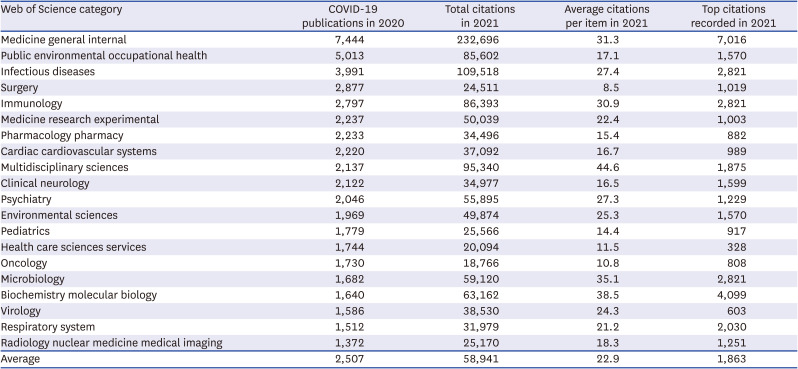
|
Web of Science category |
COVID-19 publications in 2020 |
Total citations in 2021 |
Average citations per item in 2021 |
Top citations recorded in 2021 |
|
Medicine general internal |
7,444 |
232,696 |
31.3 |
7,016 |
|
Public environmental occupational health |
5,013 |
85,602 |
17.1 |
1,570 |
|
Infectious diseases |
3,991 |
109,518 |
27.4 |
2,821 |
|
Surgery |
2,877 |
24,511 |
8.5 |
1,019 |
|
Immunology |
2,797 |
86,393 |
30.9 |
2,821 |
|
Medicine research experimental |
2,237 |
50,039 |
22.4 |
1,003 |
|
Pharmacology pharmacy |
2,233 |
34,496 |
15.4 |
882 |
|
Cardiac cardiovascular systems |
2,220 |
37,092 |
16.7 |
989 |
|
Multidisciplinary sciences |
2,137 |
95,340 |
44.6 |
1,875 |
|
Clinical neurology |
2,122 |
34,977 |
16.5 |
1,599 |
|
Psychiatry |
2,046 |
55,895 |
27.3 |
1,229 |
|
Environmental sciences |
1,969 |
49,874 |
25.3 |
1,570 |
|
Pediatrics |
1,779 |
25,566 |
14.4 |
917 |
|
Health care sciences services |
1,744 |
20,094 |
11.5 |
328 |
|
Oncology |
1,730 |
18,766 |
10.8 |
808 |
|
Microbiology |
1,682 |
59,120 |
35.1 |
2,821 |
|
Biochemistry molecular biology |
1,640 |
63,162 |
38.5 |
4,099 |
|
Virology |
1,586 |
38,530 |
24.3 |
603 |
|
Respiratory system |
1,512 |
31,979 |
21.2 |
2,030 |
|
Radiology nuclear medicine medical imaging |
1,372 |
25,170 |
18.3 |
1,251 |
|
Average |
2,507 |
58,941 |
22.9 |
1,863 |

The average number of publications in 2020 in the top 200 journals was 126 (range, 57–778) (
Table 3). The average number of total citations in 2021 for publications in 2020 was 3,671 (range, 4–54,682) for the top 200 journals. The average number of citations for the top 200 journals in 2021 per item published in 2020 was 25.7 (range, 0–270.0). The average COVID-19 impact ratio was 3.84 (range, 0.26–16.58) for 197 journals that recorded JIFs for 2020. The average JIF ratio for the top 197 journals that had JIFs for 2020 and 2021 was 1.77 (range, 0.68–8.89). The COVID-19 impact ratio significantly correlated with the JIF ratio (r = 0.403,
P = 0.010;
Fig. 1). For these journals, the JIFs for 2020 and 2021 strongly correlated (r = 0.939,
P = 0.010).
Fig. 1
Correlation between journal impact ratio and COVID-19 impact ratio. The COVID-19 impact ratio significantly correlated with the JIF ratio (r = 0.403, P = 0.010).
COVID-19 = coronavirus disease 2019, JIF = journal impact factor, JCR = Journal Citation Report.
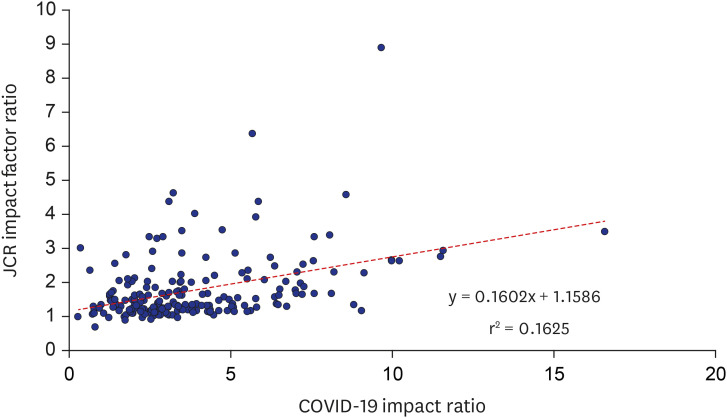

Table 3
Top 20 journal titles with COVID-19-related documents published in 2020 and their citation frequency in 2021
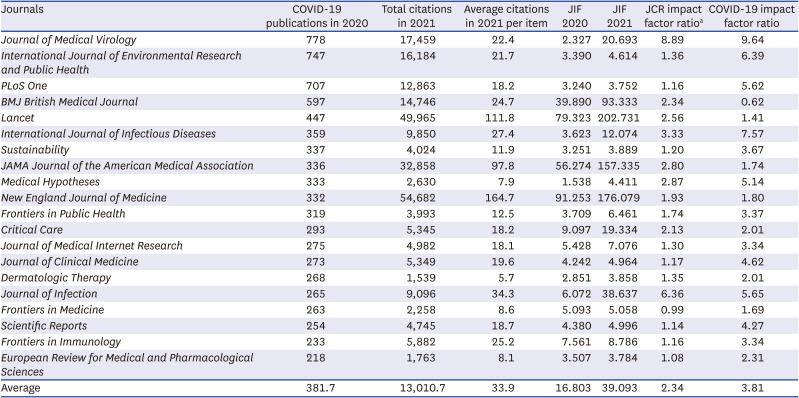
|
Journals |
COVID-19 publications in 2020 |
Total citations in 2021 |
Average citations in 2021 per item |
JIF 2020 |
JIF 2021 |
JCR impact factor ratioa
|
COVID-19 impact factor ratio |
|
Journal of Medical Virology
|
778 |
17,459 |
22.4 |
2.327 |
20.693 |
8.89 |
9.64 |
|
International Journal of Environmental Research and Public Health
|
747 |
16,184 |
21.7 |
3.390 |
4.614 |
1.36 |
6.39 |
|
PLoS One
|
707 |
12,863 |
18.2 |
3.240 |
3.752 |
1.16 |
5.62 |
|
BMJ British Medical Journal
|
597 |
14,746 |
24.7 |
39.890 |
93.333 |
2.34 |
0.62 |
|
Lancet
|
447 |
49,965 |
111.8 |
79.323 |
202.731 |
2.56 |
1.41 |
|
International Journal of Infectious Diseases
|
359 |
9,850 |
27.4 |
3.623 |
12.074 |
3.33 |
7.57 |
|
Sustainability
|
337 |
4,024 |
11.9 |
3.251 |
3.889 |
1.20 |
3.67 |
|
JAMA Journal of the American Medical Association
|
336 |
32,858 |
97.8 |
56.274 |
157.335 |
2.80 |
1.74 |
|
Medical Hypotheses
|
333 |
2,630 |
7.9 |
1.538 |
4.411 |
2.87 |
5.14 |
|
New England Journal of Medicine
|
332 |
54,682 |
164.7 |
91.253 |
176.079 |
1.93 |
1.80 |
|
Frontiers in Public Health
|
319 |
3,993 |
12.5 |
3.709 |
6.461 |
1.74 |
3.37 |
|
Critical Care
|
293 |
5,345 |
18.2 |
9.097 |
19.334 |
2.13 |
2.01 |
|
Journal of Medical Internet Research
|
275 |
4,982 |
18.1 |
5.428 |
7.076 |
1.30 |
3.34 |
|
Journal of Clinical Medicine
|
273 |
5,349 |
19.6 |
4.242 |
4.964 |
1.17 |
4.62 |
|
Dermatologic Therapy
|
268 |
1,539 |
5.7 |
2.851 |
3.858 |
1.35 |
2.01 |
|
Journal of Infection
|
265 |
9,096 |
34.3 |
6.072 |
38.637 |
6.36 |
5.65 |
|
Frontiers in Medicine
|
263 |
2,258 |
8.6 |
5.093 |
5.058 |
0.99 |
1.69 |
|
Scientific Reports
|
254 |
4,745 |
18.7 |
4.380 |
4.996 |
1.14 |
4.27 |
|
Frontiers in Immunology
|
233 |
5,882 |
25.2 |
7.561 |
8.786 |
1.16 |
3.34 |
|
European Review for Medical and Pharmacological Sciences
|
218 |
1,763 |
8.1 |
3.507 |
3.784 |
1.08 |
2.31 |
|
Average |
381.7 |
13,010.7 |
33.9 |
16.803 |
39.093 |
2.34 |
3.81 |

For the Korean journals, the average number of COVID-19 publications in 2020 in 58 Korean journals, with both JIF 2020 and JIF 2021 and listed in the Web of Science, was 5.50 (range, 0–126). They received 8.8 citations (range, 0–61.0) per item in 2021 (
Table 4). The COVID-19 impact ratio was 2.97 on average (range, 0–24.67) for the Korean journals. The average JIF ratio for Korean journals was 1.14 (range, 0.50–2.49). Twenty-five Korean journals with a COVID-19 impact ratio > 1.5 demonstrated a higher JIF ratio (1.31 ± 0.39 vs. 1.01 ± 0.18,
P < 0.001) than 33 Korean journals with a lower COVID-19 impact ratio.
Table 4
Fourteen Korean journal titles with COVID-19-related documents published in 2020 and their citation frequency in 2021
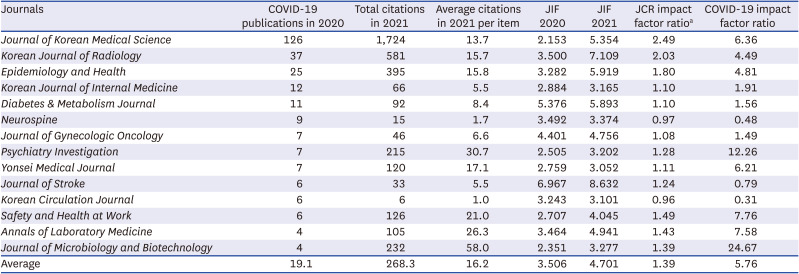
|
Journals |
COVID-19 publications in 2020 |
Total citations in 2021 |
Average citations in 2021 per item |
JIF 2020 |
JIF 2021 |
JCR impact factor ratioa
|
COVID-19 impact factor ratio |
|
Journal of Korean Medical Science
|
126 |
1,724 |
13.7 |
2.153 |
5.354 |
2.49 |
6.36 |
|
Korean Journal of Radiology
|
37 |
581 |
15.7 |
3.500 |
7.109 |
2.03 |
4.49 |
|
Epidemiology and Health
|
25 |
395 |
15.8 |
3.282 |
5.919 |
1.80 |
4.81 |
|
Korean Journal of Internal Medicine
|
12 |
66 |
5.5 |
2.884 |
3.165 |
1.10 |
1.91 |
|
Diabetes & Metabolism Journal
|
11 |
92 |
8.4 |
5.376 |
5.893 |
1.10 |
1.56 |
|
Neurospine
|
9 |
15 |
1.7 |
3.492 |
3.374 |
0.97 |
0.48 |
|
Journal of Gynecologic Oncology
|
7 |
46 |
6.6 |
4.401 |
4.756 |
1.08 |
1.49 |
|
Psychiatry Investigation
|
7 |
215 |
30.7 |
2.505 |
3.202 |
1.28 |
12.26 |
|
Yonsei Medical Journal
|
7 |
120 |
17.1 |
2.759 |
3.052 |
1.11 |
6.21 |
|
Journal of Stroke
|
6 |
33 |
5.5 |
6.967 |
8.632 |
1.24 |
0.79 |
|
Korean Circulation Journal
|
6 |
6 |
1.0 |
3.243 |
3.101 |
0.96 |
0.31 |
|
Safety and Health at Work
|
6 |
126 |
21.0 |
2.707 |
4.045 |
1.49 |
7.76 |
|
Annals of Laboratory Medicine
|
4 |
105 |
26.3 |
3.464 |
4.941 |
1.43 |
7.58 |
|
Journal of Microbiology and Biotechnology
|
4 |
232 |
58.0 |
2.351 |
3.277 |
1.39 |
24.67 |
|
Average |
19.1 |
268.3 |
16.2 |
3.506 |
4.701 |
1.39 |
5.76 |

Among the journals in the category of “medicine general internal” of the Web of Science, top 20 journals, that recorded JIFs for 2020, showed 199 (range, 95–597) COVID-19 publications in average, average total citations of 9,805.0 (281–54,682), 36.2 average citations per item in 2021 (range, 2.4–164.7), COVID-19 impact ratio of 2.69 (range, 0.62–6.36) and JIF ratio of 1.86 (range, 0.96–4.62) (
Supplementary Table 1). The
Journal of Korean Medical Science showed the highest COVID-19 impact ratio (6.36) among the 20 journals in this category.
DISCUSSION
Our study showed that COVID-19 pandemic influenced the citation frequency of publications and that a 3.8-fold increase in citations in 2021 for the documents published in 2020 as compared with JIF 2020 was observed in the top 197 journals with a higher number of COVID-19 publications. The average JIF ratio for the top 197 journals with JIFs for 2020 and 2021 was 1.77, and the COVID-19 impact ratio significantly correlated with the JIF ratio. Korean journals with a COVID-19 impact ratio > 1.5 showed a higher JIF ratio than those with a lower COVID-19 impact ratio. General medicine in the Web of Science category, had the most documents (12.8%) published in 2020, followed by public environmental occupational health (8.6%), infectious diseases (6.8%), surgery (4.9%), and immunology (4.7%).
Gong et al.
4 found that the number of COVID-19-related publications demonstrated a high growth trend in the first 10 days of February 2020, and that China published the largest number of studies, as the country was the most affected by the pandemic in its early stages. The Scopus database search for the first year of the COVID-19 pandemic between January 1, 2020, and December 31, 2020, revealed that, among the 20 highest-ranked countries by the gross domestic product, the United States of America was the most productive country (n = 13,491) in the COVID-19 and COVID-19-related domains, with one and a half times or more publications than any other country.
5
Another bibliometric analysis of COVID-19 during the early stages of the outbreak (December 2019 to June 19, 2020) indicated that articles (9,140 of 19,044 publications, 48.0%) were the most prevalent document type, followed by letters (4,192, 22.0%) and reviews (1,797, 9.4%).
6 According to another analysis of the early phase publications, in the 16,670 relevant articles dated between February 14, 2020, and June 1, 2020, the most common topics were health care responses (2,812, 16.9%) and clinical manifestations (1,828, 10.9%).
7 Research on clinical manifestations and protective measures has shown an increasing trend, whereas research on disease transmission, epidemiology, health care response, and radiology demonstrates a decreasing trend.
7 Artificial intelligence-based bibliometric analysis has shown the potential of exploring many academic publications during a public health crisis. The dominant topics related to the spread of COVID-19 were public health response, clinical care practices, clinical characteristics, risk factors, and epidemic models.
8
An analysis of the recent documents published between January 1, 2019 and January 1, 2021, in 10 high-impact medical and infectious disease journals (
New England Journal of Medicine,
Lancet,
Journal of the American Medical Association,
Nature Medicine,
British Medical Journal,
Annals of Internal Medicine,
Lancet Global Health,
Lancet Public Health,
Lancet Infectious Disease, and
Clinical Infectious Disease) showed that 1,022 (16.2%) of 6,319 studies were related to COVID-19.
9 In this meta-analysis, the authors estimated that the COVID pandemic was associated with an 18% decrease in the production of non-COVID-19 documents owing to editorial strategies using simulation models. They also found a significant decrease in the number of original articles for COVID-19 research compared with non-COVID-19 research (47.9% vs. 71.3%,
P < 0.001). More authors were associated with COVID-19 publications, especially case reports, than with non-COVID-19 publications (median, 9.0 authors ([interquartile range {IQR}, 6.0–13.0] vs. 4.0 [IQR, 3.0–6.0],
P < 0.001). The scientific quality of COVID-19-themed research was estimated to be below average with lower levels of evidence during the early period of the COVID-19 pandemic (from March 12 to April 12, 2020) in the three highest-ranked journals (
New England Journal of Medicine,
Journal of the American Medical Association,
Lancet).
10
A study reported an increase in the retraction rate related to an upsurge in the publication rate from January 1, 2020 to October 10, 2021.
11 The data from the Retraction Watch database (
http://retractiondatabase.org/) showed a total of 157 withdrawn articles on COVID-19. “No information” was a reason for retraction in the half (50%) of the articles, while other reasons for retraction included concern/issues about data, duplication, journal error, lack of approval from a third party, plagiarism, etc. Another cross-sectional study reported that more than half (59%, 27/46) of retracted COVID-19 articles remained available as original unmarked electronic documents (33% as full text and 26% as an abstract only) and that sources of articles after retraction were preprint servers, ResearchGate and, less commonly, websites including PubMed Central and the World Health Organization.
12
One study showed that the top 100 highly cited COVID-19 articles in 2020 had citations ranging from 1,147 to 20,440. The median number of citations was 1,970 (IQR, 1,456–2,939).
13 Most of the first authors were from China (58%), followed by the United States of America (16%), and the United Kingdom (7%).
New England Journal of Medicine,
Journal of the American Medical Association, and
Lancet comprised 37% of these documents. Most of the top 100 highly cited COVID-19 documents were descriptive studies focusing on the epidemiology (48%) and clinical course (60%) of COVID-19.
13
Brandt et al.
14 compared citation rates between COVID-19 and non-COVID-19 articles published over a period of 24 months (from January 1, 2020 to December 31, 2021) in 24 major scientific journals in eight selected fields. The results showed that a COVID-19:non-COVID-19 per-article citation ratio was 5.58. COVID-19 documents have showed more than 80% increase in citations relative to non-COVID-19 documents, when the influence of other variables were minimized with negative binomial regression.
Social media has the potential as a vehicle for disseminating scientific information during a public health crisis.
15 According to Taneja et al.,
15 during the first six months of the pandemic, from December 2019 through May 2020, strong correlations were identified between Twitter activity trends and preprint and publication activity (
P < 0.001 for both). Sharing and spreading information on COVID-19 in a timely manner on social media was achieved at a much faster pace. According to a study involving an artificial neural network model, the Pearson correlation coefficient between the JIF of papers with COVID-19 as a topic and its Altmetric scores was 0.185 with
P < 0.01.
16 However, Altmetric score was not precise to describe the immediacy of citations of academic publication on COVID-19 research.
16
COVID-19 continues to disrupt scientific and clinical studies and to shift research, publishing ethics, and the dynamics of the peer reviewing process to a new normal.
1718 However, research quality and integrity should not be compromised despite the innovations in research methodology and situations related to the current health crisis.
In conclusion, COVID-19 pandemic significantly impacted the trends in biomedical publications and their citations.









 PDF
PDF Citation
Citation Print
Print



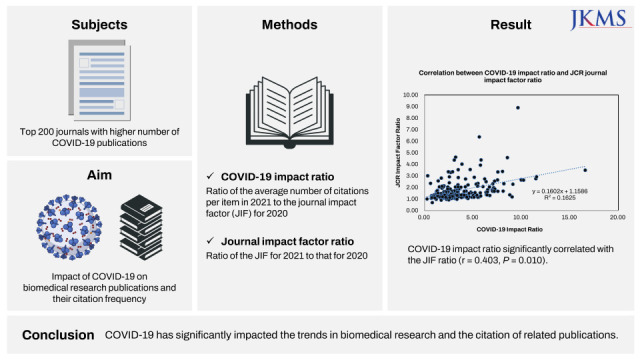
 XML Download
XML Download